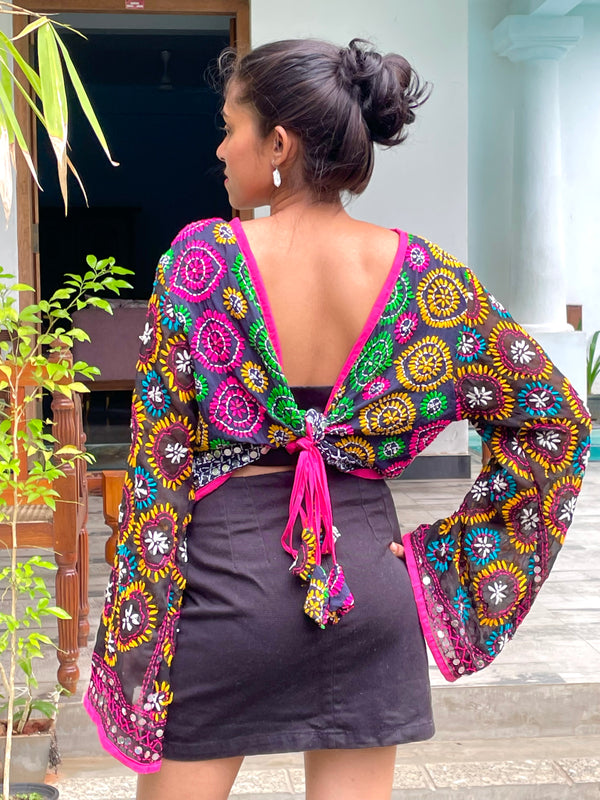Kalbeliya Gypsy Tribal Earrings-Purple Rain
Designer: BoBo GloBal
$ 38.00
Kalbeliya Gypsy Tribal Earrings- Purple Rain
Handmade Kalbeliya earrings with sterling silver posts in glorious color combos of beaded work and tassels. These bold beauties mimic the flamboyancy of the Kalbeliya tribal people. Each pair is made by a woman, a dancer from the tribe, named Moriya. She makes each piece with love and an eagerness to demonstrate a taste of her culture.
Kalbeliya tribe people are known for snake charming and trading snake venom. They are also called Saperas or Snake Charmers. The women are known for their famous Kalbelia folk dance.
"They belonged to no crowd. To no nation. Banished from cities and villages owing to their low social status, they were forced to live in jungles and eat wild animals. Until they embraced their dance and expanded beyond all boundaries into a global existence."
On our last trip to India the pandemic had just begun, the whole world was experiencing the thrashes of Covid and lockdowns. We were, on the other hand, across the world in the deserts of Rajasthan hanging out with the Kalbeliya Gypsy Tribe without even realizing the severity of the epidemic.
Our good friend Ashok introduced us to the Kalbeliya Gypsy tribe as he had in the past helping us with finding and understanding more about the Banjara tribes. We have talked about him before, you can read more about him in our 'Know The Stories' section.
Our friendship and trust with Ashok led us to these remarkable ethnic groups and allowed us to be welcomed with open arms. In March 2020 we spent some time in the camps of the Kalbeliya learning about their famous cultural dance and costume making. The Kalbelya are a reserved tribe living in Rajasthan and are negatively viewed by the local Indians, therefore in order to meet them we needed Ashok, someone that they admired and trusted, in order to gain access into their world.
The swirling moves that gypsy women make while dancing resemble to the movements of snakes. The men play the music and charm the snakes while the women use a serpentine sensuous style of dance to charm the crowds. The way these gypsy women of Rajasthan are dressed is a kaleidoscopic magic of embroidery in different hues. Their red, black, yellow and orange outfits camouflage with the colorful milieu of Rajasthan. They are often referred to as queens of the desert.
The theme of the Kalbelia songs is inspired by the stories from the folklore of Rajasthan. Some in the gypsy tribe are blessed with the rare talent of composing lyrics for songs. The gypsy music passes through generations like an art of inheritance. In 2010, the UNESCO incorporated the folk songs and dance forms from the Kalbeliya into its Intangible Cultural Heritage List.
A STORY ABOUT THE KALBELIYA
"In the late 1900’s a newborn Gulabo was buried alive a few moments after her birth. It was a normal thing to do among a tribe of people whose social class was so low they were forced to live in jungles and eat wild animals. Coming from an ancient lineage of a mystical Shaivite tantric tradition, the men of the tribe were snake handlers, also called “Sapera”. Known for aiding those who were bitten by snakes or scorpions with the help of ancient herbs or sometimes even through reading poetry, this tribe killed their girl children because they couldn’t afford to keep them in the wild, nomadic conditions they lived in.
Gulabo Sapera was rescued by her father only a few hours later. She went on to embrace the dance of the serpents her father used to charm. The rest of the women quickly followed. Centuries old chains were broken. Female infanticide came to an end. Boundaries were surpassed. All through a dance. And a fierce passion. Through the power of femininity.
This is a story of a tribe of nomadic gypsy women who embraced the dance of the serpent to break free from the antiquated systems of casteism, patriarchy, and female infanticide, to take the future of their girls and young women into their own hands, empowering not only themselves but women from all over the world through their craft- a sensual desert dance."
- From Kalbeliyafilm.com
ABOUT THE ARTISAN
Moriya (pictured in fourth photo) and her community live in a camp of tents in the desert outside of Pushkar, India. They don’t have the luxury of running water or electricity or sanitation systems. It is hard for people in her community to receive any type of government aid as they don’t have adequate ID papers or birth certificates being that they are nomadic and historically don't have a real place of residence nor have ever been accepted anywhere. The best means of survival is to entertain through dance, music, and jewelry making.




















